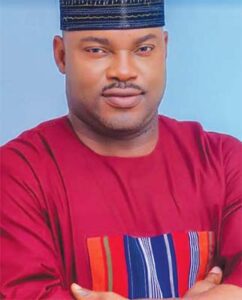
Domestic production of foam, allied materials needed to preserve forex — Vitavisco GM, Musa
Vitavisco Nigeria Limited, a subsidiary of Vitafoam Nigeria PLC was established in 2012 as part of Vitafoam’s innovative drive to revolutionise foam manufacturing in Nigeria. In this interview, Vitavisco’s General Manager and a Chemical Engineer, Joseph Musa speaks on the potentials of domestic production of foam materials and allied products to save the Country of importation to preserve foreign exchange (Forex). According to him, unawareness of quality Nigerian foam products, has been responsible for importation of same. He stated Vitavisco has strong capacity to generate forex for Nigeria on sustainable basis through foam and allied materials production. Excerpts:
What led to the establishment of Vitavisco?
Vitavisco Nigeria Limited was established in 2012. The birthing of the company was motivated by the identified gap found in the specialty foam and allied products market segment. Prior to Vitavisco, flexible Polyurethane foam in the West Africa sub region was synonymous to mattresses. It is worth noting that Vitafoam group brought creativity and a host of new initiatives in the Polyurethane Industry in West Africa sub region through the activities of its various subsidiaries.
Vitavisco specialty foam products have various applications in the furniture and interior decoration sector. The company’s molded memory foam pillows are currently the delight of consumers across the country. Furniture manufacturers are using the molded high resilience foams to create comfortable office chairs that compete with international brands. And with the recent introduction of the company’s polyethylene foam sheet into the market, furniture makers have a new weapon with which to show their creative talents in upholstery work either used as a single material or as part of a composite. In addition, the polyethylene foam sheet is used for protective packaging of furniture items during transportation. The logistics sector requires that goods under transportation are well protected against impacts that are liable to get affected items damaged. Polyethylene foam sheet has excellent cushioning effect that is unmatched by substitute materials such as open cell foam, bubble rapper, carton, among others. The products’ protective packaging applications are variously deployed in transportation of farm produce (use of fruit nets), electronic and computer equipment, furniture items, etc.
The government’s automotive policy of 2014 met Vitavisco ready regarding local capacity for the supply of molded foam component of vehicle seating. While infusion of locally manufactured parts into vehicle assembly was to commence about 2019, this objective of the policy is yet to be achieved. We are ready and expectantly awaiting full implementation of this policy. In the construction industry, the company’s polyethylene foam products are applied in ribbed slab work (as fillers), expansion joints, and insulation (either as in panel, rod or duct form.)
What were the initial challenges and how were they managed?
As earlier stated, Vitavisco began business in 2012. I was redeployed to manage the company in 2017. It is obvious I was not the pioneer General Manager. However, I was aware the company endured a number of initial challenges not uncommon for start-up manufacturing outfits. Vitavisco is a pioneer in her line of businesses. This means that technologies deployed are new to the environment and skills have to be developed to match the various technologies. This invariably means that new products and new markets have to be developed. So, it took a while before the market started to tell the difference between the products the company has for offer versus the substitute products. Vitavisco has thrived through a combination of unending curiosity, creativity and passion. These attributes are critical for success in a specialty area, and more so, for any pioneering organisation or an individual. Vitavisco deploys polymer technology to provide solutions for lifestyle, home, and industrial needs.
What are the Company’s main products?
The company’s main products include: Molded viscoelastic (memory) foam pillows, Molded high resilience foams for office and automotive seating, Polyethylene foam sheet used for protective packaging, insulation, and expansion joint applications in construction, padding material in furniture, padding material in bag making (both regular and lunch bags), etc. Also are Polyethylene foam rod used as expansion joint filler and in mattress edge; finishing Polyethylene foam duct used as insulation duct for air conditioner; waste water Polyethylene foam net used for protective packaging of agricultural produce such as fruits.
What specific problems are the products meant to solve?
Vitavisco developed a range of memory foam pillows to solve the problems of poor sleep patterns occasioned by sleeping on uncomfortable surfaces; neck and back pains often caused by using wrong pillow materials; and snoring associated with misalignment of the head and neck when using substitute pillow materials. Mattress and furniture makers, including interior decoration practitioners, across the country finally have a solution from Vitavisco to help provide their customers with sleeping and resting comfort. Most executives and other office workers in Nigeria are familiar with the ever nagging back and waste pain. In the absence of disease conditions, these problems are often as a result of using inappropriate office chair, padded with the wrong foam material. The Vitavisco molded high resilience office chair foam is designed to arrest this challenge. With our molded office chair foam, executive health and productivity are guaranteed. The polyethylene foam range of products’ applications cut across various industries solving varieties of challenges. When used as joint filler, polyethylene foam sheet and rod save the country foreign exchange as these products are imported by the various construction companies that require them. As padding material, the products also save the country foreign exchange as some event and office chair makers have been importing them from china. Some of these chair makers that are not yet aware of Vitavisco are still importing the products from China. The polyethylene foam padding material provides the furniture maker with more creative options in upholstery works. The polyethylene foam duct used in the insulation of air conditioner waste-water pipe also save the country foreign exchange. These brand of insulation ducts were being imported from China before the commencement of Vitavisco extrusion plants. The foam nets have been introduced to help curb waste in agricultural produce, such as fruits, during transportation from the farm to the market. The foam sheets have been made available to help local bag makers take their crafts notches higher. They are now able to produce bags that can compete in the international market because of the insulation effect of polyethylene foam.
Who are the Company’s target customers and what strategy is put in place to connect with them?
The company’s target customers include Quantity Surveyors, Design Engineers, Structural Engineers, Architects, Bag Makers, Furniture Makers, Mattress Makers, Interior Designers, Dealers in refrigeration components, large scale Farmers, Vehicle Original Equipment Manufacturers. The strategy to connect with the various customers has been through a combination of direct and indirect marketing, participation at industry events and opportunities such as this interview presents.
How does Vitavisco source raw materials and what are the challenges involved?
More than 90 percent of input raw materials are imported. Of course, with importation the key challenge is usually foreign exchange availability. If you finally are able to source the forex and goods arrive at the ports, then you are confronted with the ‘Nigerian factor’ at the port. Most of the raw materials we use in Vitavisco have short shelf life, usually nine months. At times, by the time the ports release the chemicals, there is hardly sufficient time left to process them to finished goods.
Does Vitavisco have plan to generate foreign exchange in the mid to long run?
In the medium term, the company would not be able to generate foreign exchange. However, in the long run the company will build capacity to play internationally and earn foreign exchange, especially if AfCFTA (Africa Continental Free Trade Agreement) is actualised and does not remain only in the agreement books.
How does the Company contribute to the growth and development of the economy?
Several areas the company contributes to the growth and development of the economy have already been highlighted, especially in applications where the products help the country save foreign exchange. Also, that the company’s products help improve health and lifestyle of its users contribute to improved productivity, which is good for the economy. The company has experienced in the last four years average annual growth of 60 percent. This has resulted in the employment of more people to join the workforce. And because of the pioneering efforts of the company, there has to be continuous training of manpower to be able to align with the requirement of our operations. These are very positive contributions to the growth and development of the economy.
Where do you expect Vitavisco to be in another five years?
I expect Vitavisco in another five years to have further expanded its product offerings into the footwear and accessories market, create more options of technical foams for various industries, and provide molded foam solutions for the automotive sector. In this period, the company will be about N10 billion in turnover.



